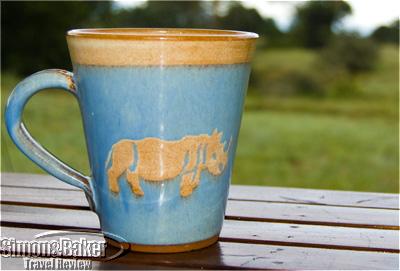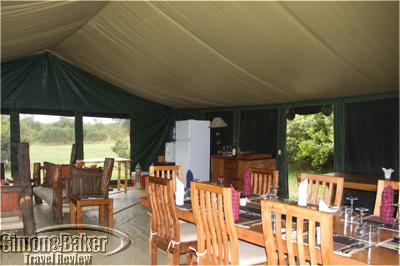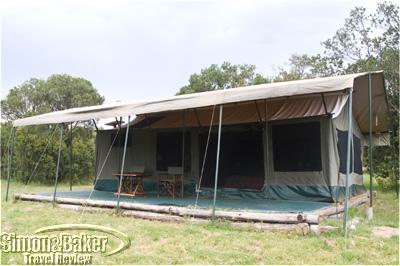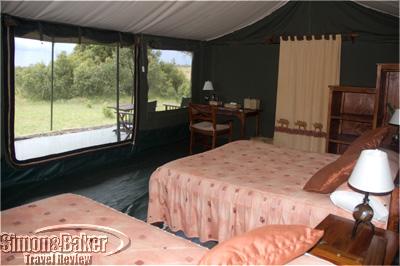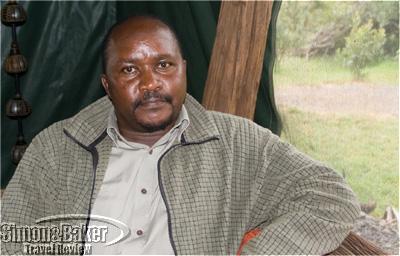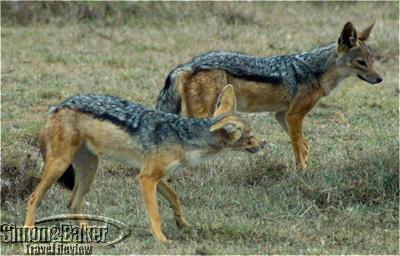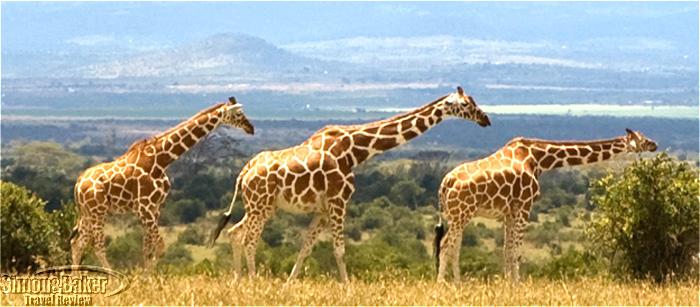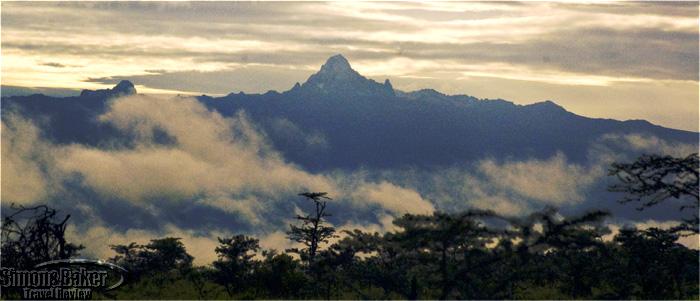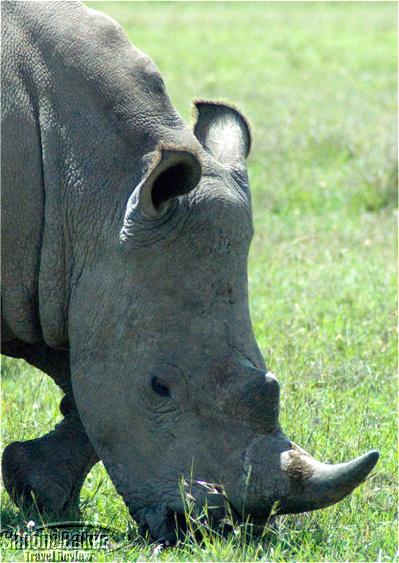
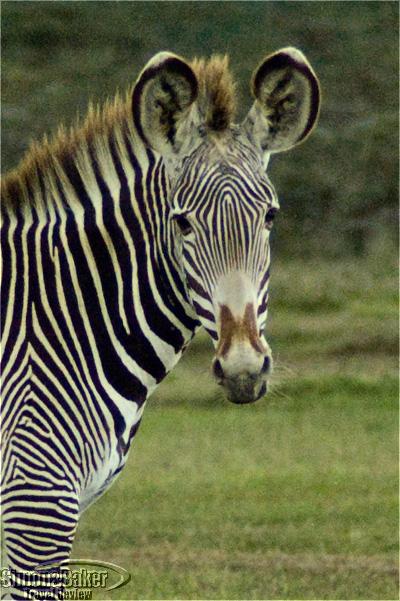
The flight from Nairobi to the nearby Nanyuki Airstrip had been delayed so that it was mid-afternoon by the time we reached the camp and the sky was overcast. But the welcome from camp manager Paul Magiri and the Samburu staff couldn’t have been sunnier or more thoughtful. Both lunch and bush shower were ready to accommodate either of my preferences. My spacious tent, a comfortably furnished room and bathroom, faced a rolling meadow dotted with trees, where gazelles liked to browse.
While the quality of the accommodations and the friendliness of the well-trained staff made for a most enjoyable visit, what made the Porini Rhino Camp unique was… the rhinos! The Ol Pejeta Conservancy was home to the endangered black and white rhinos. Following a successful black rhino translocation in 2007 from Solio Rhino Sanctuary (in the north east of the Aberdare Mountain Range), Ol Pejeta Conservancy, with 78 animals, became one of the largest black rhino sanctuaries in East Africa. Every daytime game drive during my stay brought one or more rhinos sightings often at close range, the most memorable ones a charging male black rhino and sometime later a mating pair of white rhinos. Other rare species I enjoyed seeing at the conservancy were Grevy’s zebra (the largest, wildest and most untamable of the three zebra species in Africa) and Jackson’s hartebeest. Additionally, the conservancy was home to the Sweetwaters Chimpanzee Sanctuary, possibly the only place in Kenya where this highly endangered species can be seen. Open in 1993, Sweetwater provided long-time refuge to 43 chimpanzees evacuated from their Central and West African countries of origin due to civil wars.
This combination of outstanding wildlife and stunning views across the open plateau of Ol Pejeta and the surrounding mountains made for a unique safari experience that I will treasure and recommend to friends looking to venture out of the usual safari circuits.
Communications There was no Internet connection at the camp. Bluetooth and mobile phone service was unreliable. When available, it required a GSM 900/1800 compatible international cellular phone.
General Manager Paul Magiri
Handicapped Access No
Length Of Stay Three nights
Location At the equator in central Kenya, northwest of Mount Kenya, one hour’s drive from Nanuyki, the capital of Laikipia East District, 120 miles (190 kilometers) north of Nairobi.
Owned-Managed Gamewatchers Safaris (Jake Grieves-Cook was the managing director)
Power All electricity was solar generated. The tents had electric lighting, but not sufficient power to charge batteries. Batteries for cameras, telephones and laptops could be charged from a small solar-powered generator in the camp manager’s office tent.
Size The eight acre (three-and-a-quarter hectare) camp consisted of six guest tents capable of accommodating up to 12 guests. It employed a staff of 18, including two guides and two spotters.
Year Open-Renovated 2007
Room My 390 square foot tent (36 square meters), Number Five, sat on a ground-level wooden platform covered with weatherproof floor matting. The floor platform extended the length of the tent to form an outside deck shaded by a canvas awning and furnished with two canvas chairs and a small wood table. The tent entrance was a zippered “door” in the center of the front panel. Side walls were zip-up flaps over netting-covered “windows”. Inside, one queen-size and one double bed with wooden headboards, each with their own bedside table and reading lamp occupied one side of the tent. Indoor lighting was produced through solar electricity. A partition at the far end of the tent separated the sleeping room from the bathroom. A writing desk with a canvas armchair sat on one side of the central curtained doorway, while an open-front armoire with storage shelves and a clothes-hanging rod occupied the other side. Blue and white striped cotton bedside rugs completed the décor.
During my visit, I sighted: black rhinoceros, white rhinoceros, elephant, hippopotamus, lion, black-back jackal, spotted hyena, zorilla (a.k.a. stripped polecat), chimpanzee, patas monkey , vervet monkey, olive baboon, warthog, reticulated giraffe, Burchell’s zebra, Grevy’s zebra, duiker, Kirk’s dik dik, eland, wildebeest, impala, Grant’s gazelle, Jacksons hartebeest, Thompson’s gazelle, waterbuck, beisa oryx, impala, suni, steinbok. Birds included: Masai ostrich, African goshawk, African hoopoe, black-shouldered kite, buff-crested bustard, golden-breasted bunting, grassland pipit, hammerkop, Hildebrandt starling, lilac-breasted roller, red-billed firefinch, secretary bird, speckled weaver
Porini Rhino Camp was run and maintained according to strict responsible tourism guidelines regarding conservation of the environment (including use of natural resources and solid waste and sewerage disposal) as well as providing development opportunities for the local community. At the time of my visit, 90 percent of the staff was from the local Masai Samburu community. All meat products were supplied by the cattle ranch on the Conservancy grounds and produce was sourced from local farmers.
Shortly after my visit, Porini Safari Camps and its parent company Gamewatchers Safaris were honored with the Responsible Tourism Award for “Best for Conservation of Endangered Species outside Protected Area” at the World Travel Market in London. The award, sponsored by Virgin Holidays, recognized Porini and Gamewatchers “for demonstrating that a high revenue, low impact tourism development approach can benefit the local Maasai through developing conservancies and tourism in partnership with safari companies to create employment and community income and to conserve their land for wildlife.”
Date Of Last Visit November 2008
Reviewers Article and photographs by Josette King
Service My tent was serviced twice daily, a morning cleaning and evening turn down service . Every member of the staff I encountered was consistently attentive, friendly, helpful and professional.
Would You Stay There Again? Yes
Contact Information
- Porini Safari Camps
- Village Market Complex
- P.O. Box 388-00621
- Nairobi, Kenya
- + 254 (20) 7123129
- + 254 (20) 7121851
- + 254 (20) 7122504
- + 254 (20) 7120864
